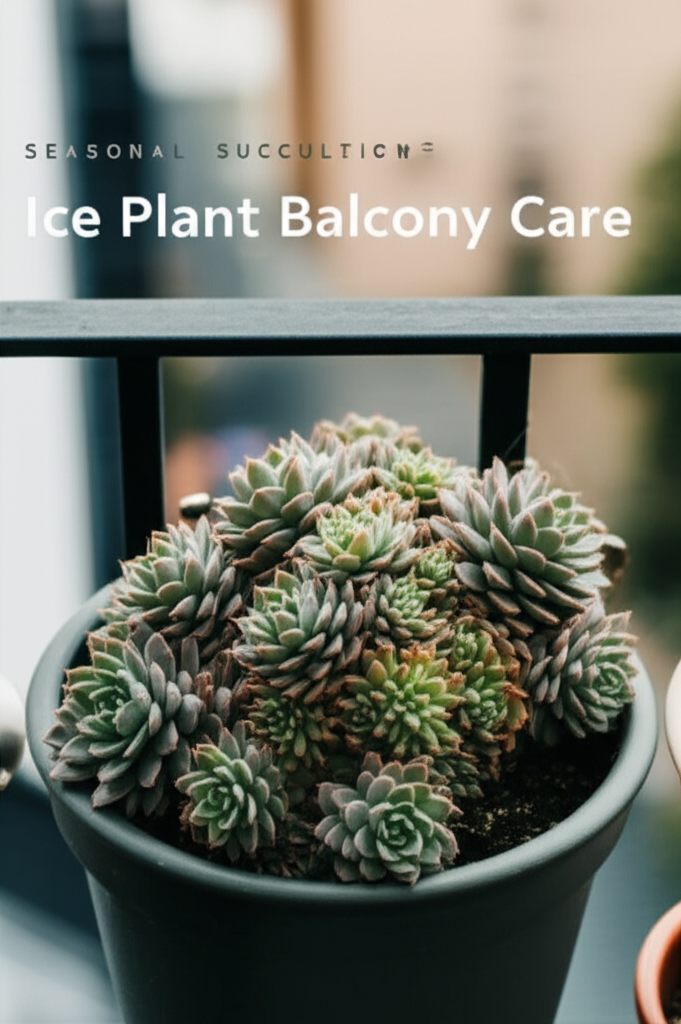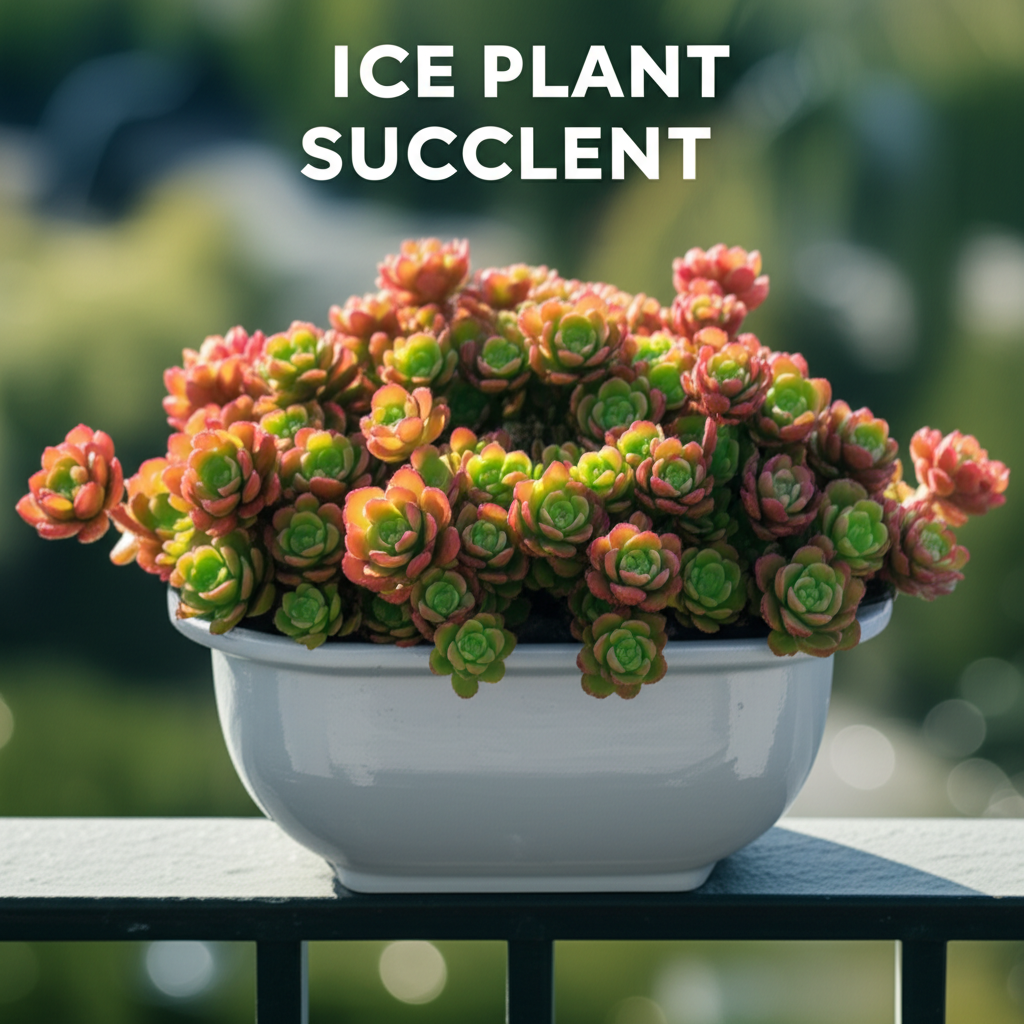The Allure of the Ice Plant Succulent
Ice plant succulents, scientifically known as Mesembryanthemum, are a captivating group of plants renowned for their jewel-like foliage and vibrant, daisy-like flowers. These drought-tolerant wonders are perfectly suited for balcony gardens, offering a splash of color and unique texture with relatively low maintenance. Their most distinctive feature is the presence of specialized epidermal cells, called papillae, which refract light, giving the illusion of glistening ice. This fascinating characteristic, coupled with their hardiness and diverse species, makes them a popular choice for urban gardeners seeking to bring a touch of nature’s artistry to their living spaces.
Understanding Ice Plant Succulent Needs
Before delving into seasonal care, it’s crucial to understand the fundamental requirements of most ice plant succulents. They are native to arid and semi-arid regions, which dictates their preferences:
- Sunlight: They thrive in full sun, requiring at least six hours of direct sunlight per day for optimal growth and flowering.
- Soil: Excellent drainage is paramount. A gritty, well-draining potting mix, such as a cactus or succulent blend, is ideal.
- Water: Overwatering is the most common cause of demise. Allow the soil to dry out completely between waterings.
- Temperature: Most varieties prefer warm temperatures and are not frost-tolerant.
Spring: Awakening and Propagation

As the last frost of winter recedes, your balcony ice plant succulent is ready to awaken from its dormant period. Spring is an excellent time for propagation and to provide a nutritional boost.
Spring Care Checklist:
- Repotting: If your succulent has outgrown its container or the soil has become compacted, spring is the ideal time to repot. Choose a pot that is only slightly larger than the current one and ensure it has drainage holes. Refresh the soil with a well-draining succulent mix.
- Fertilizing: Introduce a balanced, diluted liquid fertilizer (e.g., 10-10-10 or a specialized succulent fertilizer) once a month during the active growing season (spring and summer). Avoid fertilizing during dormancy.
- Propagation: Spring is prime time for propagating ice plant succulents from cuttings.
- Select healthy, non-flowering stems.
- Using a clean, sharp knife or scissors, cut a stem about 3-4 inches long.
- Allow the cutting to callus over for a few days in a dry, shaded spot. This prevents rot.
- Dip the callused end in rooting hormone (optional but recommended).
- Plant the cutting in a pot filled with well-draining succulent soil.
- Water lightly and place in a bright, indirect light location.
- Roots typically form within a few weeks.
- Pest Inspection: With new growth appearing, it’s a good time to inspect for common succulent pests like mealybugs or spider mites. Treat any infestations promptly with insecticidal soap or neem oil.
Summer: Peak Growth and Vibrant Blooms
Summer is when your ice plant succulent will be at its most vibrant. Consistent sunlight and careful watering are key to supporting its peak performance.
Summer Care Essentials:
- Watering: Water thoroughly when the soil is completely dry. The frequency will depend on your climate, pot size, and the specific ice plant variety. As a general rule, check the soil moisture by sticking your finger about two inches deep. If it feels dry, it’s time to water. During extremely hot periods, you might need to water more frequently, but always err on the side of caution to avoid overwatering.
- Sunlight: Continue to provide ample sunlight. In regions with intense afternoon sun, some varieties might benefit from partial shade during the hottest part of the day to prevent scorching, but most ice plants are quite resilient.
- Deadheading: As flowers fade, deadhead them by snipping them off at the base. This encourages the plant to produce more blooms rather than expending energy on seed production.
- Monitoring: Keep an eye on your plants for any signs of stress, such as wilting or discoloration, which could indicate issues with watering or pests.
Autumn: Preparing for Dormancy
As the days shorten and temperatures begin to cool, your ice plant succulent will start to transition into its dormant phase. Autumn care focuses on gradual reduction of watering and protecting it from early frosts.
Autumn Care Guidance:
- Watering Reduction: Begin to reduce watering frequency significantly. Allow the soil to dry out more between waterings. The plant’s growth will naturally slow down, and it will require less moisture.
- Protection from Frost: Ice plant succulents are not frost-tolerant. As temperatures approach freezing, move potted plants to a sheltered location, such as an unheated garage, sunroom, or indoors near a bright window. If they are in a protected balcony area, ensure they are shielded from any direct frost.
- Pruning: Light pruning can be done in autumn to remove any dead or damaged foliage, which can help prevent disease over winter.
- Soil Acclimation: If you are bringing your plants indoors for the winter, allow them to acclimate gradually to the indoor environment to minimize stress.
Winter: Rest and Conservation
Winter is a period of rest for most ice plant succulents. The key is to provide minimal care to conserve energy and prevent rot.
Winter Care Strategies:
- Minimal Watering: Water only if the soil is bone dry and the plant shows signs of severe dehydration, which is rare during dormancy. Overwatering in cool, damp conditions is a recipe for root rot.
- Light: Provide as much bright, indirect light as possible. If plants are indoors, place them near south-facing windows.
- Temperature: Maintain cool but frost-free conditions. Ideal winter temperatures are typically between 40-50°F (4-10°C). Avoid placing them near heat vents or drafty windows.
- Dormancy Observation: Your ice plant may not show much new growth during winter, and this is perfectly normal. Focus on observing the plant for any signs of distress.
Key Ice Plant Succulent Seasonal Care Comparison
This table provides a quick overview of the primary care adjustments needed for your balcony ice plant succulent throughout the year.
| Season | Sunlight Needs | Watering Frequency | Fertilizing | Key Actions |
|---|---|---|---|---|
| Spring | Full Sun | When soil is dry | Once a month (diluted) | Repotting, Propagation, Pest Check |
| Summer | Full Sun (partial shade in extreme heat for some) | When soil is dry | Once a month (diluted) | Deadheading, Monitoring |
| Autumn | Full Sun | Reduced frequency (when soil is dry) | None | Frost Protection, Light Pruning |
| Winter | Bright, Indirect Light | Very minimal (only if bone dry) | None | Conserve energy, Monitor for stress |
Troubleshooting Common Ice Plant Succulent Issues
Even with diligent care, you might encounter some common problems. Understanding the causes and solutions will help keep your ice plant healthy.
Common Problems and Solutions:
- Yellowing Leaves: This is often a sign of overwatering. Reduce watering frequency and ensure the soil drains well.
- Mushy or Soft Stems/Leaves: Another indicator of overwatering, leading to root rot or stem rot. Improve drainage and allow the soil to dry out completely. You may need to remove affected parts.
- Stretched or Leggy Growth (Etiolation): This happens when the plant isn’t receiving enough light. Move it to a brighter location.
- Brown or Crispy Leaf Tips: Can be caused by underwatering, low humidity, or inconsistent watering. Ensure you are watering thoroughly when dry, and consider misting in very dry indoor environments during winter.
- Pest Infestations (Mealybugs, Spider Mites): Treat with insecticidal soap, neem oil, or by wiping them off with a cotton swab dipped in rubbing alcohol.
Table: Ice Plant Succulent Care – Pros and Cons by Season
This table outlines the benefits and potential challenges associated with each season’s care routine.
| Season | Pros of Care Routine | Cons of Care Routine |
|---|---|---|
| Spring | Encourages new growth and flowering. Excellent time for plant multiplication. | Risk of overwatering newly propagated cuttings. Potential for pests to emerge. |
| Summer | Maximizes flowering and overall plant health. Lush foliage development. | Requires consistent monitoring of watering needs to prevent drought stress or overwatering. Risk of scorching in extreme heat. |
| Autumn | Prepares the plant for a healthy dormant period. Prevents frost damage. | Risk of fungal diseases if pruning is not done or if plants remain too wet. Forgetting to bring plants indoors before frost. |
| Winter | Allows the plant to conserve energy. Prevents root rot from excessive moisture. | Requires vigilance to avoid overwatering. Risk of insufficient light leading to weakened plants. |
Conclusion: A Rewarding Balcony Companion
The ice plant succulent is a truly rewarding plant for any balcony gardener. By understanding its seasonal needs and providing consistent, appropriate care, you can enjoy its unique beauty and vibrant blooms year after year. Remember that observation is your best tool; pay attention to your plant’s signals, adjust your watering and light accordingly, and you’ll be well on your way to a thriving succulent display. Whether you’re a seasoned succulent enthusiast or a beginner, the ice plant offers a delightful and relatively forgiving gardening experience, adding a touch of crystalline magic to your urban oasis.


